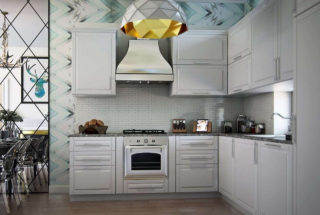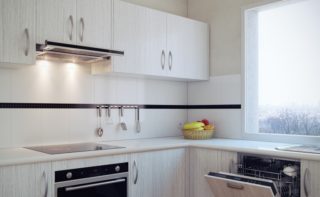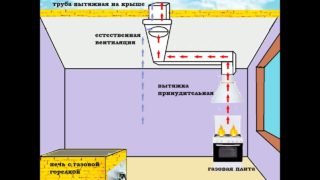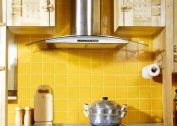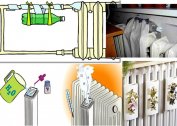A kitchen hood is an important element that draws air and removes dirt, grease, unpleasant odors from it. For effective cleaning of air masses, it is necessary to pre-calculate the dimensions of the kitchen hood. You need to make the correct calculation taking into account the norms of SNiP, SanPiN, the dimensions of the plate and other important criteria.
Hood requirements
A cooker hood is a device that cleans the air of contaminants generated during cooking. The main parameter for choosing a device is performance directly related to power.
There are norms of SNiP, in which the criteria for different types of kitchens are prescribed. For a kitchen with an electric stove with two hobs, a hood with a capacity of 60 cubic meters / hour is selected. For three and four rings these values will be 75 cubic meters / hour and 90 cubic meters / hour. A gas stove will require 100 cubic meters / hour.
For independent calculations, there is a formula by which the minimum exhaust performance is found: P = 12 × S × Hwhere R - power (performance), S - area of the kitchen, N - the height of the kitchen. Coefficient 12 sets SES.
The dimensions of a kitchen set are not directly proportional to performance. Different models may have the same power, but differ in size, so you should look at the passport data.
Types of hoods by mounting method
The dimensions of the kitchen hood directly depend on the method of fixation. There are several varieties:
- Outboard. The device is mounted above the stove. It contains filters that need to be changed periodically. Dimensions can be compact, so such a device can be placed even in a small kitchen.
- Recessed. The device must be built into a cabinet or other box, which is bought in a store or manufactured independently. May have a pull-out panel, which increases the functional area for the duration of the hood. Embedding the device in a cabinet has design advantages.
- Dome. They have high power and are connected to central ventilation. They come in different shapes. The height of the dome can reach 125 cm.
- Corner Suitable for installation in non-standard kitchens, where due to the design features it is impossible to use other models.
The appropriate type can be selected depending on the individual characteristics of the room. The hood can be connected to ventilation to draw air, so you need to consider the need for pipe installation.
Hood width
The most important parameter in the calculation of dimensions is the width. According to the requirements, it must correspond to the dimensions of the hob or be slightly larger in order to effectively clean all air masses. You can’t take less, otherwise part of the discharge will pass by the hood and settle on the ceiling.
On sale you can find hoods of different widths. The most common width is 60 cm. The model range is also provided with products with the following standard sizes: 30 cm, 45 cm, 50 cm, 80 cm, 90 cm, 100 cm and 120 cm. The last two types are sold infrequently, since they are practically not used on ordinary apartment kitchens. Their main field of application is restaurants and cafes with professional cookers, for which hoods are custom-made.
Depth and height selection
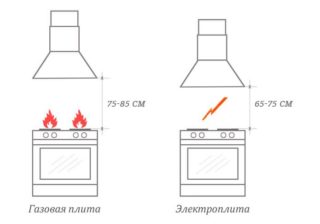 Depth is taken into account for a domed and built-in duct.Many modern products with a dome are made in the form of squares, so their length and width are equal. Depth varies between 45-90 cm.
Depth is taken into account for a domed and built-in duct.Many modern products with a dome are made in the form of squares, so their length and width are equal. Depth varies between 45-90 cm.
If a built-in device is selected, the size criterion depends on the dimensions of the cabinet in which the hood will be installed. Most recirculation models have a pull-out panel that increases their depth and increases work efficiency.
Dome-type products can have a height of 125 cm. This must be taken into account when purchasing and plan ahead for placement so that the device fits.
The minimum distance between the cooker and the hood must be taken into account. For gas stoves, it is at least 65 cm, for electric stoves at least 60 cm. If an inclined hood is used, the distance will be slightly less - 55-65 cm for a gas stove and 35-45 cm for an electric stove.
Reduce the height should not be. This may result in a hazardous situation or the hood may malfunction. If the value increases, the performance may deteriorate; therefore, the above standards should be adhered to.
Duct application
The size and location of the hood is affected by the need to connect to the duct. The best option is to place the device under the ventilation hole. This allows you to minimize the route of the duct and increase the performance of air purification from pollution.
A similar installation is not possible in every kitchen. Then apply special pipes. In this case, it is also necessary to calculate their correct location so that the pipeline passes at a right angle and has a small number of bends.
Pipes made of aluminum or corrugated plastic are suitable for work. The diameter for the hood in the kitchen is 80, 100 and 129 mm. The cross section can be square and round. To connect using various connectors. The dimensions of the cross section of the duct and the outlet must be the same so that the contact is safe and reliable, and the discharge of contaminated air is stable.
Pipes can be mounted hidden or open. In the second case, repair and maintenance are facilitated, but fixing will be required after about every meter. For the connection, brackets and clamps are used. A valve is also placed in the shaft to prevent the penetration of extraneous odors back into the room.

